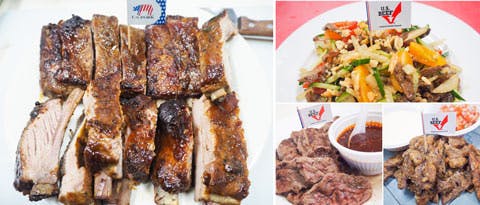Culinary Program Focused on Creating Demand for U.S. Beef, Pork in Vietnam
Creating greater demand for U.S. pork and educating chefs on the benefits of using portion-controlled U.S. beef cuts, USMEF hosted Vietnamese importers at a U.S. meat culinary program in Singapore. The two-day workshop was funded by the Pork Checkoff and the Beef Checkoff Program.

Sabrina Yin, USMEF director in the ASEAN region, performs a cutting demonstration for Vietnamese importers
One participating company is one of the few Vietnamese U.S. meat importers that buys portion cuts of U.S. beef directly from the United States. It also purchases U.S. beef trimmings for use in ground beef, so on the first day of the program USMEF distributed fact sheets showing 101 ways to make a burger –demonstrating the versatility of U.S. beef.
USMEF-ASEAN Director Sabrina Yin discussed the importance of proper cooking methods and preparation to bring out the best qualities in the selected beef cuts. She explained that although the entire chuck roll can be used for ground beef, some parts of the cut can be served as chuck eye steak. Another concept presented by Yin was using the chuck underblade as a steak after removal of connective tissue and excess fat.
Yin described three different uses for the U.S. beef heel muscle:
- Braised in five-spice powder and tossed with salsa;
- Country fried steak; and
- Using the center cut portion for yakiniku grill meat.
“The demonstration session enabled the participants to appreciate the different textures of the various cuts, and showed them new ways to serve U.S. red meat at an economical price,” said Yin.
USMEF also emphasized the benefits of portion-controlled cuts which can deliver savings by reducing waste and lowering storage expenses and butchering costs.

U.S. pork spare ribs and dishes made with U.S. beef heel muscle were cooked and sampled
Eddie Hui, USMEF-ASEAN marketing and communications specialist, followed with an informational session on using technology in the foodservice industry. Hui focused on the availability of online resources and mobile apps for chefs.
At the end of the first day, the class enjoyed dinner at Tomo Izakaya, a Japanese concept restaurant in Singapore on Clarke Quay, where participants were served a variety of U.S. beef and pork dishes.
The second day of the program focused on U.S. pork production and the suitability of U.S. pork cuts and specifications for different cuisines.
A later session explained how to conduct promotions in partnership with USMEF, detailing promotional materials and past promotions in the region to illustrate ways to stretch marketing budgets with USMEF’s help.
Lunch featured a cutting and cooking demonstration of U.S. beef head meat, chuck roll, chuck flap tail, short plate and heel muscle, as well as U.S. pork spare ribs, CT butt, loin and sausages.
The program wrapped up with a quiz to reinforce what had been taught over the two days.
“A big part of the program was focused on education, because we need to keep customers of U.S. beef and pork informed and hope that they share the information with colleagues and others in the food industry,” said Yin. “When you can show them how to take a U.S. beef or pork cut and use it in several different ways to make several different kinds of dishes, it really sparks interest in our products and increases sales, and that’s our goal.”
